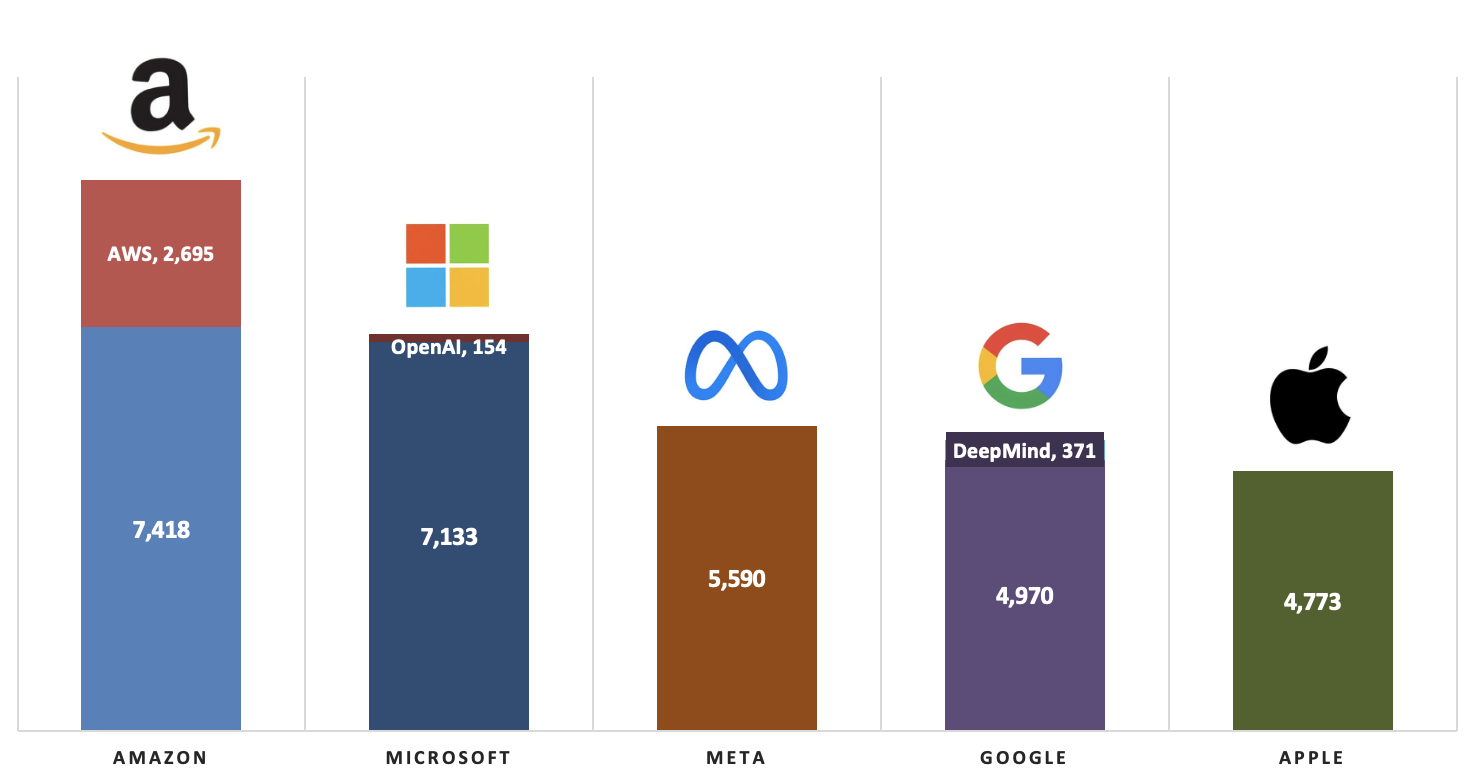Bloomberg uses glass.ai to write about the AI Armies of the Tech Giants.
Introduction
Industry analysts believe that recent developments in AI represent a fundamental technological shift, as important as the creation of web browsers or the launch of the iPhone. The success of ChatGPT has accelerated the ongoing race for AI supremacy among the tech giants. Nothing says a high-stakes race like Google’s issuing a “code red”, and OpenAI launching GPT-4 and Google launching the PaLM API on the same day, both large language models (LLMs) that produce human-like text.
The outcome of this technological race will be determined by a variety of factors including leadership focus, computing resources and, above all, the sheer number of talented AI researchers and programmers. Several articles have covered the AI race between the tech giants, but so far, there has been limited data about the size and characteristics of the ‘AI armies’ of the top tech companies. This is the purpose of our analysis. Bloomberg gained exclusive access to the data and recently published this article.
At glass.ai we have built an AI research capability that deep-reads the web to understand companies and sectors. We decided to apply our capability to research the core AI teams at the following tech giants:
Microsoft + OpenAI
Google + DeepMind
Apple
Meta
Amazon
Methodology
To identify and gather details about the AI employees, our AI deep crawled the websites of the tech giants, and read the LinkedIn profiles of their hundreds of thousands of employees. To shortlist the ‘core’ AI teams, the crawler looked for people with the following terms/phrases in their job titles and descriptions:
AI, AI Architect, AI Developer, Artificial Intelligence, Autonomous Vehicle, Big Data, Computer Vision, Data Analyst, Data Science, Data Scientist, Deep Learning, Language Models, LLM, Machine Intelligence, Machine Learning, ML, Natural Language, Neural, NLP, Research Scientist.
We excluded people working in finance, sales, marketing, HR and other ‘non-technical’ departments. For example, those employees within Google working in AI recruitment, the sales professionals at Microsoft selling AI solutions, etc. We also excluded more generic technical roles like ‘software engineer’ or ‘software developer’ even though many people with these job titles can be working on AI. It was too difficult to determine the level of AI focus for the generic roles based on publicly available information and we concluded it would give us too many false positives.
In terms of geographical coverage, the research was global, across countries and languages, as our aim was to uncover the global AI workforces at these large technology companies.
The results below provide new data and insights into the roles, locations and skills of the core AI teams inside the tech giants. We acknowledge the actual size of their AI teams is probably larger, but also believe that our analysis represents a very good proxy for their core AI teams. The underlying data with details of the companies and employees can potentially be made available for validation.
Size of the AI armies
The crawler identified and deep-read the details of over 33,000 core AI employees working for the tech giants. We were surprised to discover that Amazon has the largest number of AI employees with a total of 10,113 people. Our expectation was that Microsoft or Google would come top, but Amazon surpassed everyone else. Microsoft came a distant second with 7,287 employees (including OpenAI), followed by Meta (5,590), Google (5,341 including DeepMind) and Apple (4,773). It was also interesting to see the relatively small sizes of the core AI teams at companies like OpenAI and DeepMind. As we know, these companies have spearheaded recent AI breakthroughs.
We also looked at the percentage of AI employees as a proportion of the total workforce. Here we discovered that Meta appears to have the highest concentration of AI people. Even though the perception is that Meta has focused on the Metaverse and Google/Microsoft have led the AI race (through DeepMind and OpenAI), the data shows that Meta’s concentration of AI employees is more than double that of the proportion we see in the other tech giants:
Meta (5.59k AI employees / 86k workforce = 6.50%)
Microsoft (7.28k AI employees / 228k workforce = 3.19%)
Google (5.34k AI employees / 178k workforce = 3.00%)
Apple (4.77k AI employees / 164k workforce = 2.90%)
Amazon (10.11k AI employees / 1.5m workforce = 0.67%)
Location of the ‘troops’
While AI is a global industry, there are clusters of activity and development. The highest concentration of AI personnel for the tech giants is in the United States. This is expected given that these companies are all US-based, however, they also have large AI teams in the UK, India, and then to a lesser extent in Canada, Germany, Ireland, Israel, Australia, Singapore and Spain. In total, we identified AI employees in 50+ different countries. The analysis below shows the top 10 countries for each company.
Amazon has almost half its total number of AI employees outside the US and large numbers in India:
Google highly concentrates its AI teams in the US, the UK (where DeepMind is headquartered) and then other western countries:
Microsoft is not too dissimilar to Amazon, with about half the AI employees outside the US and a significant number in India:
Meta is heavily concentrated in the US and the UK:
While Apple has a large presence in the US, but also has a significant presence in European countries like Ireland and Spain:
Roles and skills of the AI teams
The tech giants employ AI personnel in a large variety of roles from research and development (employees who develop the core AI algorithms), to data scientists who apply these methods to end-user applications. The development of AI algorithms has become a vast discipline with many sub-disciplines — natural language processing (NLP), machine vision, and machine learning — each of which has its own sub-domains e.g. reinforcement learning, self-supervised learning.
The ‘research scientists’ (core AI algorithm developers) are, arguably, the most valuable cohort of AI people in these companies. When one views these companies through this lens, we have a ‘winner’: Microsoft.
Microsoft + OpenAI = 2,089 R&D
Amazon = 1,906 R&D
Meta = 1,897 R&D
Google + DeepMind = 1,485 R&D
Apple = 553 R&D
However, Meta is not far behind, and the company also has a large number of employees in the ‘data science’ category:
Gender balance
While there has been a concerted effort to attract more women into tech, the gender balance is still poor and AI is no different. To analyze the gender balance within the core AI teams at the tech giants, we assigned the gender to an individual based on their first name. This method gave us the following categories: confidence female, mostly_female, ambiguous ->. We only took ‘female’ so that any person with a name that could be both wasn’t misinterpreted.
The results showed how OpenAI is very male-dominated (despite having a high-profile female CTO). Over three/quarters of the AI teams at DeepMind are men, and generally speaking for the tech giants, two-thirds (or more) of all AI employees are males. Clearly, there is a lot of work to do to achieve gender parity and attract more female AI talent to these companies. AI services are known to contain biases learnt from the data they are trained on, therefore it is vital to have diversity in the AI workforce to minimise such effects.
Recruitment velocity
In our analysis, we also investigated how fast the companies have been recruiting AI personnel. We gathered the data by looking at the years when the AI employees started their current roles. While all tech giants have had a steady increase in AI talent (see chart below), Amazon has seen the most significant jump in the recruitment of AI talent over the last few years. Meta has been amassing a large pool of AI talent, perhaps playing catch-up with the other tech giants. Microsoft and Google have ramped up their recruitment efforts but more slowly, whilst Apple seems to be lagging behind, with a bigger focus on computer vision hires. We expect this ongoing ‘war’ for AI talent to continue and the recruitment drive to accelerate, despite the recent rounds of layoffs at the tech giants.
We were surprised by the recruitment velocity at Amazon and Meta. Looking deeper into the recent hires at Amazon, we noticed a significant increase in the hiring of ML Data Associates/Analysts, Data Scientists, ML Research Scientists and similar roles. It’s hard to tell what’s been driving this surge in recruitment, but we suspect it might be related to products like Alexa. ML Data Associates tend to work closely with internal customers like the Machine Learning Science modelling teams, providing the critical data they need to improve product speech recognition and NLP models.
With regards to Meta, we can see that many recent hires have been AI research scientists and data scientists, both R&D-intensive roles. The company has been hiring at a faster pace than Google and Microsoft. In June 2022 Meta announced a new decentralized organizational structure for Meta AI, and the company recently released LLaMA, a foundational large language model that helps experts tease out the problems of AI language models, from bias and toxicity to their tendency to simply make up information. Despite Meta’s focus on the metaverse (they even changed their name), the company has been playing a growing role in the Large Language Models (LLMs) space.
Conclusion
We hope this analysis is a good start to understanding the size of the AI teams at the tech giants. The winners of this AI arms race are likely to reap massive financial rewards similar to the winners of previous tech cycles (internet, mobile, social media). Will Amazon come out as the leader given the large size of their AI army? Will it be decided by key R&D labs/companies like DeepMind or OpenAI? Will access to data be the key factor (therefore Google or Meta could win)? We don’t know at this stage. We will continue to track how these AI armies evolve and potentially we could gain deeper insights into the roles, teams, previous companies, and academic backgrounds of the AI employees working for the tech giants.
We would like to point out that the study didn’t analyze the AI armies of the Chinese tech giants (Baidu, Tencent, Xiaomi, Bytedance) or the new crop of AI startups that have collectively raised many hundreds of millions of dollars in funding (e.g. Anthropic, Cohere, Character.ai, Inflection AI, Adept, etc.). These are also key players in the AI race that we can track with our research capability. Moreover, we could also analyse the AI armies of specific countries, as we know there is an ongoing AI arms race between the West and China. But these are topics for another post.
If you are interested in this data or if you need help researching companies and sectors globally, do not hesitate to get in touch: info@glass.ai.












